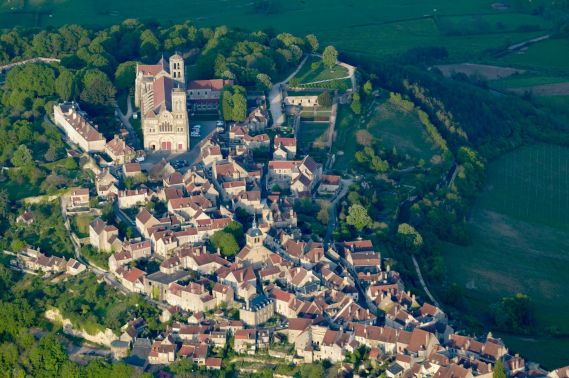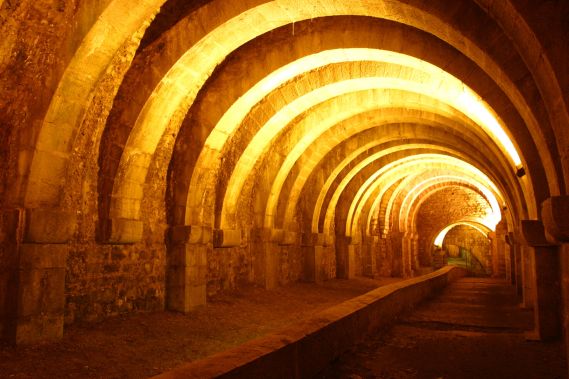WORLD HERITAGE IN BURGUNDY-FRANCHE-COMTÉ
Burgundy-Franche-Comté is thus, along with the South of France, the French region with the most sites and properties on the UNESCO World Heritage list. An exceptional concentration that testifies to the richness and cultural diversity of the region.
Fontenay Cistercian Abbey – Côte d’Or (21)
Founded in 1118 by Saint Bernard, Fontenay Abbey is one of the oldest Cistercian monasteries in France. Its Romanesque architecture gives it a remarkable homogeneity with all the 12th-century convent buildings. These have come down to us intact after surviving more than nine centuries of history. Following Saint Bernard’s rigorous plan, visitors can successively discover the church, dormitory, cloister, chapter house, scriptorium and heated room, as well as the forge.
As the perfect extension to any visit to the Abbey’s halls, the large French-style gardens and new landscaped gardens invite the public to discover a wide variety of plants, hundred-year-old trees and numerous watercourses, including a trout pond.
A private property, Fontenay Abbey was one of the first French monuments to be listed as a World Heritage Site, in 1981.


Vézelay Basilica and Hill – Yonne (89)
Pilgrims converged on Vézelay from the beginning of the 11th century from all of Christendom. Vézelay was designed as a lighthouse and the Benedictines, the owners of the abbey dedicated to Mary Magdalene, whose relics they claim to preserve, welcomed and directed crowds of pilgrims and crusaders to Rome, Jerusalem and Santiago de Compostela.
Vézelay’s Basilica and hill are among the first French possessions listed as World Heritage in 1979, then again in 1998 under the Route to Santiago de Compostela. A place of history, spirituality and art, the “archetype” of pilgrimage towns, an important place of commerce surrounded by ramparts, Vézelay provides its visitors with an enlightened testimony of the ancient abbey church, whose sculpted 12th-century decoration is a work of exceptional quality.
Since the 19th century and the iconic restoration by Eugène Viollet-le-Duc, Vézelay has also been the meeting place for artists and writers.
The Chapel of Notre-Dame in Ronchamp – Haute-Saone (70)
The Chapel of Notre-Dame du Haut, the pilgrim’s shelter, the chaplain’s house and pyramid of peace form a mecca of modern architecture in Ronchamp. These 4 buildings, together with 16 other sites by Le Corbusier, are the work of this major 20th-century architect, added to UNESCO’s World Heritage list in July 2016.
Built in 1953 and inaugurated in 1955, the Chapel of Notre-Dame du Haut unleashed the passions of detractors who called it a bunker or mosque, while its admirers immediately understood that an architectural revolution had just occurred. Le Corbusier treats light as a material in its own right: the skylights and the southern wall, the “wall of light”, invite meditation and direct the gaze to the sky.
The site is a symbol of the revival of sacred art in the 20th century.


The citadel and Vauban’s fortification ensemble in Besançon – Doubs (25)
The history of Besançon and its Citadel is intimately linked to that of its architect: Vauban, commissioner of fortifications in the 17th century under Louis XIV.
Listed as a UNESCO World Heritage Site since 2008, Besançon’s fortifications have been ingeniously adapted to the city’s geographical features and are now a remarkable example of military architecture. The centrepiece of the fortifications, the Citadel, is considered one of the best in France, offering from its ramparts spectacular panoramas of the old centre and omnipresent surrounding nature.
A tourist and cultural centre, the Citadel is home to three museums labelled as “Museums of France”. The Comtois Museum, the Museum of Resistance and Deportation and, unexpected in this unusual place, the Museum of Natural History with its animal spaces illustrating biodiversity like nowhere else.
Chalain and Clairvaux Lakes (prehistoric pile dwelling sites around the Alps) – Jura (39)
Since June 2011, prehistoric pile dwelling (stilt house) sites around the Alps have been listed as World Heritage sites by UNESCO. These sites are said to be serial and transnational. They comprise 111 sites, out of some 1000 known sites, in the six countries of the Alpine arc (Switzerland, Austria, France, Germany, Italy, Slovenia). They are representative of prehistoric habitations from the period between 5000 and 500 BC, set up near the main bodies of water in the Alpine arc. The pile dwellings are an “invisible cultural entity” whose potential was revealed only after archaeological digs. The pile dwellings are the first underwater cultural asset to be inscribed.
These sites have come down to us thanks to their special conservation conditions, which have allowed the preservation of organic materials (wood, food scraps, fabric etc), thus providing valuable information on daily life on the shores of alpine lakes 5000 years ago. The archaeological area of Clairvaux-les-Lacs lets you discover 40 years of research around the Jura’s lakes as well as the reconstruction of a lake habitation and items unearthed.


La Grande Saline in Salins-les-bains – Jura (39)
Listed as a UNESCO World Heritage Site since 2009, La Grande Saline in Salins-les-Bains is a testament to 1,200 years of ignigene salt production (obtained by artificial evaporation). Unique in Europe, this medieval industrial site, one of the oldest in France, still retains exceptional technical and architectural elements, witnesses to thousand-year-old know-how.
Since the 8th century, La Grande Saline has exploited its naturally salty springs. Built in the 13th century to protect the saltwater wells, the underground gallery, like a cathedral to honour salt, extends its vaults to a length of 165 metres. In the heart of this grandiose underground space, a 19th-century pendulum, driven by a large hydraulic wheel, activates a pump still in operation today.
In the Middle Ages, La Grande Saline was a large-scale factory which allowed Salins-les-Bains’ influence to spread. Until the beginning of the 19th century, La Grande Saline was without doubt the most important salt producer in Franche-Comté.
La Saline Royale of Arcs-et-Senans – Doubs (25)
A unique architectural ensemble which has featured as a Unesco World Heritage Site since 1982, La Saline Royale in Arc-et-Senans, willed by the power of Louis XV, remains Claude Nicolas Ledoux’s masterpiece.
Built between 1775 and 1779, this factory dedicated to the production of salt brings together, functionally and symbolically, eleven buildings saved from destruction several times after industrial production ended in 1895. An emblem of Enlightenment architecture, La Saline Royale can be discovered in several images. It is first and foremost an integrated factory where almost the entire working community lived. It is also a theatre whose stage wall would consist of the “Bernes” and the “Director’s House”. Finally, it is a visual expression with the refined use of embossed facades, columns, pediments, circles and attic rooms designed to be brought to life just by the daily movement of the sun.


The “Climats” of Burgundy’s vineyards – Côte d’Or (21)
The “Climats” (parcels of vines) of Burgundy’s vineyards have featured on the World Heritage List since 2015, as a cultural landscape, that is, as “the combined works of man and nature, which express a long and intimate relationship between people and their environment”.
Don’t be fooled by the term “climat”. In Burgundy, it doesn’t refer to the weather, but instead to the wine region. Here, a “Climat” refers to a precisely demarcated and named plot of vines, which produces a wine with a unique taste, which bears its name. Montrachet, Romanée Conti, Chambertin, Les Cailles, Les Amoureuses, Clos des Mouches … there are more than 1,200 “climats” across the entire listed site, between Dijon and the Maranges, south of Beaune.
For 2000 years, this vine culture has gradually created a unique and diverse heritage: the low walls and dry-stone huts (cabottes) of the vineyard, the winemakers’ homes in the villages, as well as the monuments of the cities of Dijon and Beaune. This architectural heritage materialises the imprint of the monks, the Valois Dukes of Burgundy, the merchants and winemakers who have shaped and protected the “Climats” in their turn. Today, the “Mission Climats” ensures the sustainability of the site as well as sharing it with others. The “Maison des Climats” is the reference exhibition.
© 2019 Office de tourisme La Charité-sur-Loire, Bertranges, Val de Nièvres
Legal information






